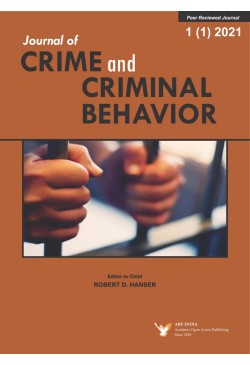
Journal of Crime and Criminal Behavior
Frequency :Bi-Annual
ISSN :2583-0244
Peer Reviewed Journal
Punishing Image-based Sexual Abuse: Public Perceptions of Appropriate Sanctions
Youth Unemployment, Crime Incidence and the Challenges of Youth Development Programmes in Delta State, Nigeria
Ngboawaji Daniel Nte, Ucheawaji Nathaniel Nte, Clairmont Roger Featherstone & Eyengho, Ogbe Evans (2024). Youth Unemployment, Crime Incidence and the Challenges of Youth Development Programmes in Delta State, Nigeria. Journal of Crime and Criminal Behavior, 4: 1, pp. 25-63. https://doi.org/10.47509/JCCB.2024.v04i01.02
A Qualitative Measure of Veterans Treatment Courts Efficacy
Frederick Lux, Ashraf Esmail, Charlene Cofield & Michelle Phillips-Meek (2024). A Qualitative Measure of Veterans Treatment Courts Efficacy. Journal of Crime and Criminal Behavior, 4: 1, pp. 65-89. https://doi.org/10.47509/JCCB.2024.v04i01.03
Cybercrimes and Safety Policies to Protect Data and Organizations
Bahaudin G. Mujtaba (2024). Cybercrimes and Safety Policies to Protect Data and Organizations. Journal of Crime and Criminal Behavior, 4: 1, pp. 91-112. https://doi.org/10.47509/JCCB.2024.v04i01.04
Judgments of Guilt toward Mentally Ill Defendants
Sydney Garrison & Melissa A. Baker (2024). Judgements of Guilt toward Mentally I11 Defendants. Journal of Crime and Criminal Behavior, 4: 1, pp. 113-128. https://doi.org/10.47509/JCCB.2024.v04i01.05
Mitigating Forensic Risk for Practitioners
Julie S. Costopoulos & Marshall A. Jones (2024). Mitigating Forensic Risk for Practitioners. Journal of Crime and Criminal Behavior, 4: 1, pp. 129-138. https://doi.org/10.47509/JCCB.2024.v04i01.06
How Mass Media Promotes Consumer and Criminal Behavior: A Theoretical Perspective on Consumer Criminology
Ashek Mahmud (2024). How Mass Media Promotes Consumer and Criminal Behavior: A Theoretical Perspective on Consumer Criminology. Journal of Crime and Criminal Behavior, 4: 1, pp. 139-155. https://doi.org/10.47509/JCCB.2024.v04i01.07